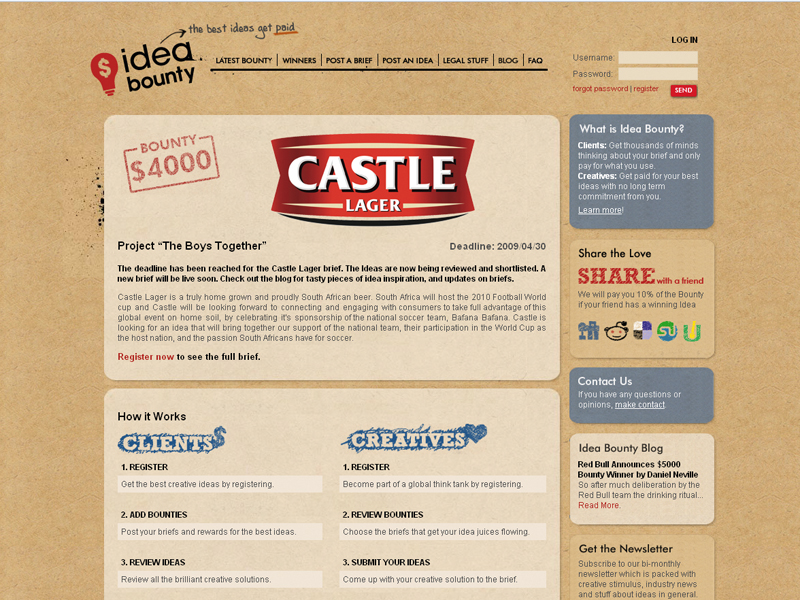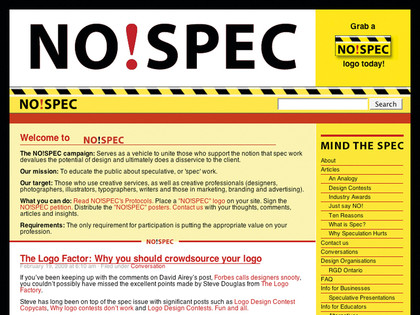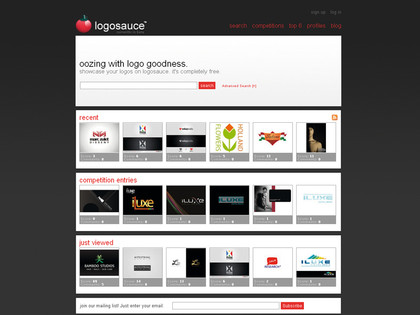Why web designers shouldn't work for free

Speculative work. In its strictest interpretation, this refers to any project that's undertaken with no guarantee that you'll be paid. Many web designers think this is a very bad thing indeed, driving down fees, devaluing the profession and encouraging a culture of poor design.
Others think it gives them a way to get their work seen, building their web design portfolio and democratising the design process. To decide which side of the divide you fall, it's best to know exactly what is meant by 'spec work'.
The circumstances in which the description might apply are many – from pitching creative work all the way up to doing freebies for charity. That's quite a range, with some practices more prevalent and less maligned among the anti-spec work lobby than others. Let's take a look at those definitions and the arguments that go with them.
Credentials pitching, the creative equivalent of prepping for a job interview, is on the very bottom rung of the spec work ladder. Sure, it takes time to sort out your portfolio, tailor your presentation and attend a meeting, but few of us would begrudge the fact that a new client might want some face time before actually signing up for your services. This is especially true if you're relatively new to the industry.
But increasingly, clients will ask for more than a flick through your CV and a look at some links. They'll want you to sketch out ideas or even show them a mock-up or two. This is 'creative pitching' and chances are that if you're asked to do it, you're not the only outfit in your client's sights.
This is the point at which all the arguments for and against spec work begin to mean something. There are two types of creative pitching: the kind where you invoice your client at the end of the process and the kind where they look at you like you're from Mars when you tell them your day rate.
When design is your job, creative pitching for free is working for free. Whether you think that's good or bad for your business will depend on a number of factors – in particular, how well established you are. "We get asked to pitch ideas. We say 'no'," chuckles Paul Boag, creative director at Headscape.
Sign up for breaking news, reviews, opinion, top tech deals, and more.
"Actually, it's not so black and white. Once in a blue moon we'll do it. Our attitude is that if they're immediately fighting us over our process and way of working then that doesn't bode well for the rest of the project.
"I'm talking literally about spec work here though: doing design work up front," Boag continues. "We put a huge amount of effort into our proposal writing, which is full of screenshots of other pieces of relevant work. We pour effort and time into the sales process. We just don't feel that producing designs up front is a) the most convincing argument and b) the best use of time for the client."
Practical pitching
Other agencies take a more pragmatic approach to free pitching. "We're a reluctant participant," says Fraser Black of branding agency Firedog. "It's a buyer's market – a very competitive, crowded market – the design business."
He suggests there may be some benefit in trying to persuade clients that a credentials pitch, with some case studies and budget discussion, might be an acceptable alternative to a full creative pitch. "We're very detailed in the way we track and trace our participation in pitching. In fact, every pitch is assigned a job number."
That way, the company knows exactly what they've spent on the process – which helps when costing future projects. They can also tell what's paying dividends – and credentials pitching wins. "Credentials pitching is 60 per cent more successful for us than full creative pitching – but even then you have hard costs associated."
Even when an agency accepts that free pitching is part of the process, they acknowledge its downside. "Some companies treat this process as the project itself and struggle with the idea of 'a concept'," says Mark Allaradice, Pod1's head of creative.
"To fully answer a brief you need sufficient research, strategic planning and an understanding of the client's objectives. This will not come out of a creative pitch, but will evolve through a relationship with the agency and the client upon winning the project."
Winner takes all
While creative pitching may divide opinion – with some saying it's working for free and others saying it's a necessary step in the struggle to win jobs – everyone loves a competition, right? Wrong. Campaigning website NO!SPEC says that design competitions are just vast, indiscriminate creative pitches.

DIVIDED LINES: The idea of spec work is very contentious, with some arguing it devalues the whole industry
"Creative competitions sidestep the importance of the client/designer relationship. Competitions and speculative projects are about winning the work," reads a template letter that the campaign suggests designers send to competition organisers.
"Choosing a designer or firm is about getting the right professional for the project. Requests for speculative work erode the relationship and are a substitute for a client doing their homework." Not all competitions are for high stakes, but the anti-spec lobby can take a dim view of any request for design work without payment.
Carsonified discovered this when an innocently worded blog post asked the design community to create a slide for its Future of Web Design conference. Nearly 200 comments followed, almost half of them accusing the design and web company of promoting unethical practices.
"We were a bit blindsided by the reaction to that," says Ryan Carson, head honcho at Carsonified. "I've been involved in design for a number of years and up until that point I'd never heard anybody call a 'for fun' competition spec work. It's vital for young designers to do competitions like this to promote themselves."
In this instance there was no 'work' to be had. The slide that designers were asked to create would never have been a paid job – the opportunity was created specifically for the competition. But competitions can replace the pitching process too. The LogoSauce website specialises in this, giving clients an interface where they can publish their requirements and participants from around the globe can upload as many designs as they like.
With competitions attracting between 30 and 50 entries and 'prizes' rarely over $200, that's a lot of work for little return. And there can only be one winner. Many entries see nothing for their effort. Still, LogoSauce is keen to defend its stance. "Competitions aren't meant to replace the designer pitching process," says David Vaasen, the man behind the site. "Instead they should be seen as a complementary way to raise a designer's profile, meet new clients and more."

EFFORT VS REWARD: You need to be careful over how much time you invest in free work because at the end of the day, you might not get paid